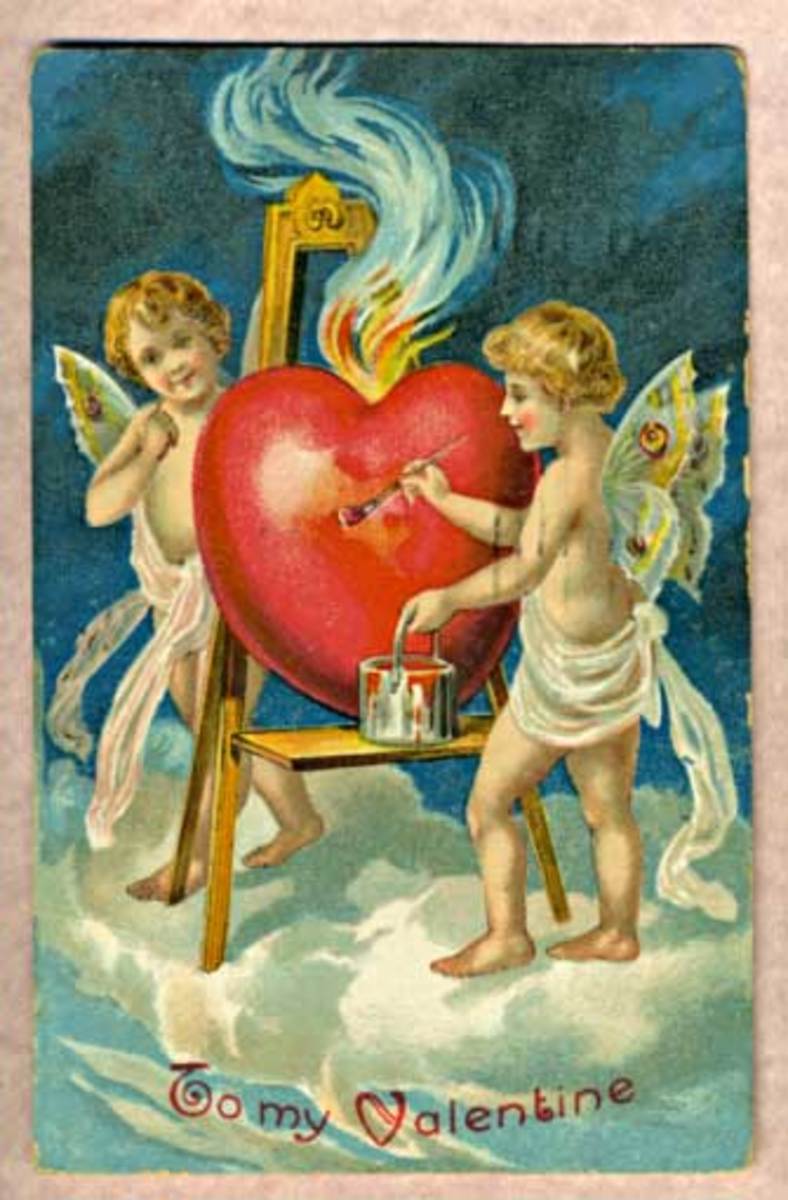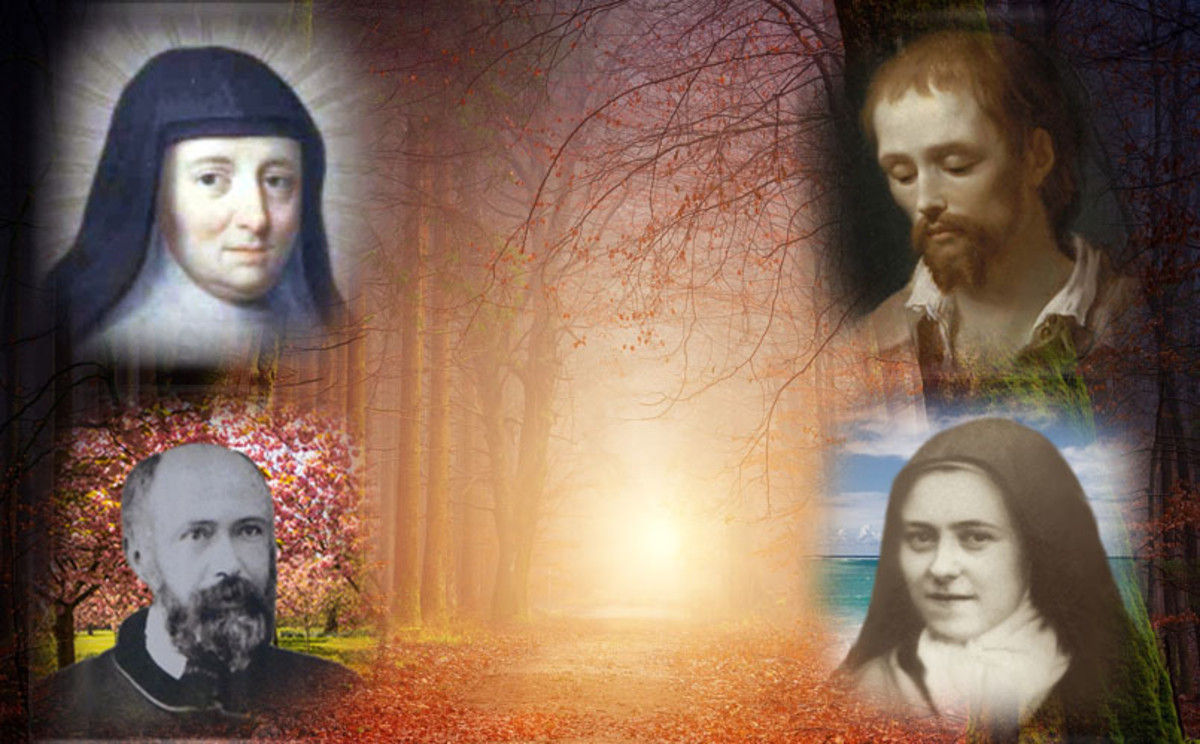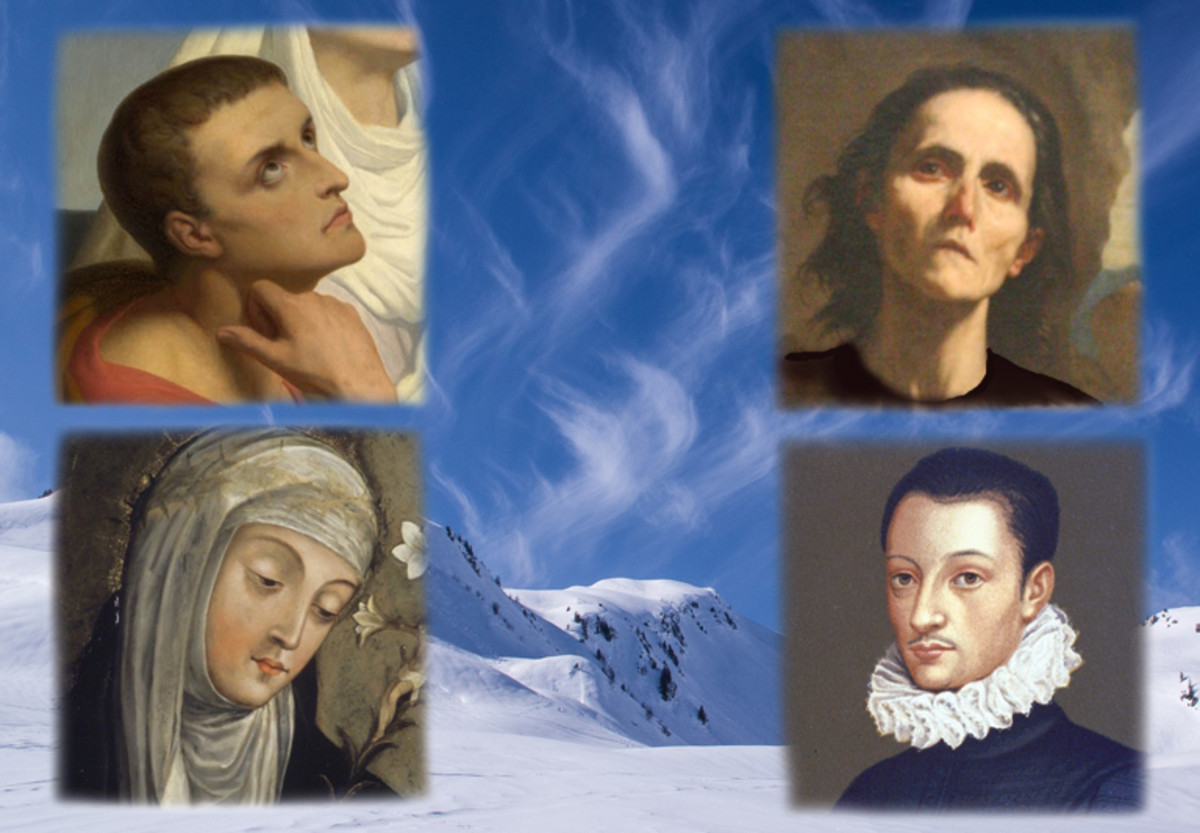Saint Valentine - and Romance

The Saint?!
Each year in February, when Valentine’s Day is almost upon us the shops are full of cards, chocolates, flowers, teddies and all manner of romantic gifts, for lovers to exchange on the most romantic day of the year ~ 14th February; Saint Valentine’s Day.
But who was Saint Valentine, and just what, exactly, was so romantic about him?
I decided to find out.
I knew that the Roman Catholic online encyclopedia ~ ‘New Advent’ ~ was likely to be useful, so I started there.
Information from New Advent
When it comes to Saint Valentine, it seems that I should not be asking ‘who was?’, but, rather, ‘who were?’
Yes, there was more than one. In fact, there were more than two! There were three of them! (Actually, New Advent states that there were ‘at least’ three of them, so there could even be more!)
Christian martyrs all; recorded in the ‘martyrologies’ ~ and all under 14th February!
The three known Valentines of history:
1] A 3rd century priest of Rome
2] A 3rd century bishop of Interamna (Terni)
3] A martyr of Africa
Nothing is known about the third one, but the first two are buried along the Flaminion Way. Rome’s Porta del Popolo, which used to be called the Flaminion Gate, was also known, around the 12thcentury, as the Gate of Saint Valentine. It was, apparently, named after a little church, dedicated to the saint, which was situated nearby.
http://www.newadvent.org/cathen/15254a.htm

Saint Valentine Baptizing St. Lucilla - Jacopo Bassano / Jacopo da Ponte - 1500s
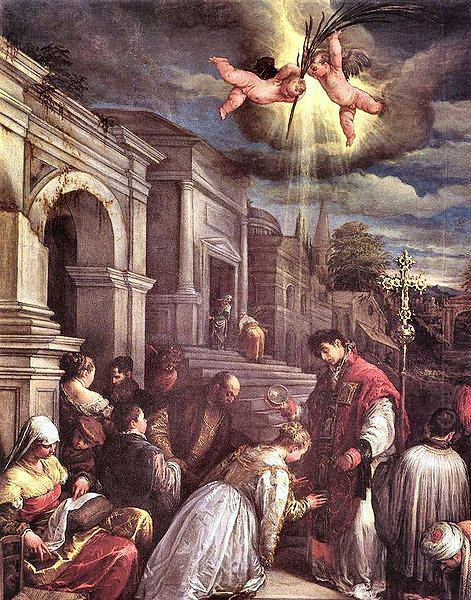
Young Romantic Love?
But how did these three saints, jointly, become representative of young romantic love?
According to ‘New Advent’, it was something to do with the date. Saint Valentine's Day was believed to be the point of the year when birds paired up in Spring. They quote Chaucer:
“For this was sent on Seynt Valentyne's day
Whan every foul cometh ther to choose his mate.”
[Geoffrey Chaucer: Parliament of Foules]
As such, it was considered, in France and England, to be a day for exchanging tokens of love, as described in the literature of the 14th and fifteenth centuries. Authors include John Gower, Lydgate and Clauvow.
The 15th century Paston letters are also mentioned, where Dame Elizabeth Brews refers to birds choosing their mates on Saint Valentine’s Day. Her daughter then writes a letter "Unto my rightwell beloved Valentine, John Paston Esquire" ~ so sending ‘valentines’ goes back some time.
http://www.newadvent.org/cathen/15254a.htm
*
Next, I decided to try an encyclopedia ~ or, rather, the well-known online encyclopedia: Wikipedia.
What could Wikipedia add?
Old-Fashioned Valentines

Goodies for Valentines Day
Information from Wikipedia
Can Wikipedia provide us with more information?
According to Wikipedia, there were 14 martyred saints named Valentino / Valentinus ~ not all related to 14th February. 'Valens' means 'worthy' or 'strong' and this became a popular name during 'Late Antiquity'.
The Eastern Orthodox Church reveres the Presbyter Valentine on 6th July, though, interestingly, the name day for those called Valentina or Valentino is still 14th February. However, the Greek Orthodox Church does not recognise a saint named 'Valentine'.
Wikipedia quote: 'The feast of St. Valentine was first established in 496 by Pope Gelasius I, who included Valentine among those "... whose names are justly reverenced among men, but whose acts are known only to God".'
The site comments that Jack Oruch ~ a historian ~ has concluded that there was no tradition of Saint Valentine being connected to lovers, or of romantic links to Saint Valentine's Day, before Chaucer made the suggestion. Chaucer wrote about 'courtly love', so probably found a links where previous writers had not.
And even this may not concern 14th February!
Wikipedia states that Chaucer's poem, which includes references to mating birds on Valentines Day, was 'written to honor the first anniversary of the engagement of Kingrichard II of England to Anne of Bohemia', but it goes on to remind us that mid-February would be 'an unlikely time for birds to be mating in England'. Apparently, there is an alternative date, which would be more appropriate ~ 'May 2 is the saints' day for Valentine of Genoa'.
http://en.wikipedia.org/wiki/Valentine's_Day
http://en.wikipedia.org/wiki/Saint_Valentine
Cup Cake Valentines

St Valentine Kneeling In Supplication - David Teniers III - 17th Century
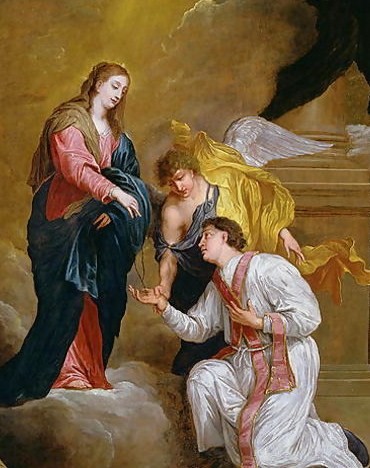
Interesting Details
Some interesting details from Wikipedia:
'In 1797, a British publisher issued The Young Man’s Valentine Writer, which contained scores of suggested sentimental verses for the young lover unable to compose his own .....'
'Paper Valentines became so popular in England in the early 19th century that they were assembled in factories. Fancy Valentines were made with real lace and ribbons...'
'Since the 19th century, handwritten notes have given way to mass-produced greeting cards. ...'
'In the second half of the 20th century, the practice of exchanging cards was extended to all manner of gifts in the United States. Such gifts typically include roses and chocolates ...'
'The U.S. Greeting Card Association estimates that approximately 190 million valentines are sent each year in the US.....'
http://en.wikipedia.org/wiki/Valentine's_Day
http://en.wikipedia.org/wiki/Saint_Valentine
*
The ‘Saints’ pages of Catholic.org should be able to help further. What do they have to say?
Valentine Book Cover + Detail from St Valentine Baptizing St. Lucilla - Jacopo Bassano

Valentine Kids Books
Information from Catholic.org
Catholic.org repeats the story that Valentine was a martyred priest in Rome.
Why was he martyred?
There are a number of linked suggestions, but, basically, he helped Christians, which was considered unacceptable at this time ~ the reign of Claudius II (‘Claudius the Goth’), whom he defied.
He is said to have aided Saint Marius and other Christians, and also refused to renounce his Christian faith. He was, accordingly, arrested. It is said that, at first, Claudius was lenient with him ~ that is, until he realised that Valentine was attempting to convert him. As a result, he was beaten , stoned and, finally, beheaded outside the Flaminian Gate, on 14th February, c269AD. This was followed by burial on the Flaminian Way
A church was built in memory of Valentine, by Pope Julius, near what is now the Porta del Popolo ~ once the Porta Valentini. Apparently, archaeologists have unearthed both this church and a Roman catacomb, which, this site Roman Catholic website affirms, proves that ‘Whoever he was, Valentine really existed’.
Apparently ‘His name is celebrated as that of an illustrious martyr in the sacramentary of St. Gregory, the Roman Missal of Thomasius, in the calendar of F. Fronto and that of Allatius, in Bede, Usuard, Ado, Notker and all other martyrologies on this day'.
Although this one man is specifically noted, the site acknowledges that ‘The origin of St. Valentine, and how many St. Valentines there were, remains a mystery’.
It also mentions Pope Gelasius, saying that it was he who, in 496 AD, ‘marked February 14th as a celebration in honor of his martyrdom’. According to the article, a millennium had to go by before ‘The first representation of Saint Valentine appeared’. This was in 1493, in ‘The Nuremberg Chronicle’, which they describe as ‘a great illustrated book ‘.
http://www.catholic.org/saints/saint.php?saint_id=159

Valentine's Gifts-Rromantic Pillow Cases
What about love and romance?
Catholic.Org mentions this legend ~
While imprisoned, having discovered that his jailor’s daughter was blind, Valentine miraculously restored her sight. Later, when he learned that he was to be executed, he wrote her a letter, signed "From your Valentine", a phrase which has been added to many a card received, in recent years, on Valentine’s Day.
The site confirms that Valentine is the patron saint of love, lovers, engaged couples and happy marriage, but adds a few more: young people, bee keepers, epilepsy, fainting, greetings, plague and travellers.
Since young people are associated with young love, that link may be expected, and ‘greetings’ go with the cards that so many people send, but bee keepers and travellers?? Or epilepsy, fainting, and plague? ~ Well, saints have always been invoked when there are health problems around.
Are there any clues, on the site, as to why Valentine is linked to love and marriage?
Yes, there are three;
1. It states that, when helping the Christians in Rome, Valentine is believed to have married young couples.
2. It describes representations of Valentine ~ stating that he is shown with birds and roses. This links back to the symbolism of birds mating in spring and possibly to the romantic notion of flowers being exchanged by lovers.
3. It explains how Christian ministers tried to replace a mid-February pagan custom ~ related to boys and girls, a goddess, and, presumably, sexual activity, in mid-February ~with Christian devotion.
Apparently, this heathen ‘superstitious custom’, had no connection at all with Saint Valentine, except (loosely) the date ~ February 15th. It was, actually, connected with the pagan goddess Februata Juno. Apparently boys would draw the names of girls for this ‘lewd’ ritual. Substituting the names of Christian Saints was considered to be a way of ridding society of the custom.
http://www.catholic.org/saints/saint.php?saint_id=159
*
The 'Religious Tolerance' site usually has something interesting to say on various subjects~ let's take a look!

Bold Loft Love Pillow Cases

ReligiousTolerance.Org - On Lupercalia and Juno februata
According to ReligiousTolerance.Org, Valentine's Day has its roots in two Roman festivals ~ Lupercalia and the feast of Juno Februata.
It also notes, however, that some people consider that there is no link between these events and Saint Valentine's Day, and that traditions associated with the latter only came into being at the time of Geoffrey Chaucer.
*
Apparently, Lupercalia, on 15th February, was both a purification and a fertility festival, described as a Roman "festival of sexual license". It was held at the Lupercal Cave, where Romulus and Remus were, supposedly, reared by a wolf (perhaps the word 'Lupercal' relates to this she-wolf).
The Luperci priests were described by Cicero as ‘a certain wild association of Lupercalian brothers’. Aided by Vestal Virgins, they sacrificed animals and then used the skin to flog Roman women, in order to purify them. This was followed by feasting.
*
Pagan Rome dedicated all of the month of February to Juno Februata, but her feast was the 14th. ‘Februata’ is related to the word ‘fever’ and refers to the fever of love ~ she was the goddess of marriage and of women. On 14th February men would draw women’s names for ‘erotic games’. The ‘temporary liaison’ lasted for a year and ‘Sometimes marriages resulted’.
The Christian church tried to get rid of these erotic games, but with little success.
A ‘cleaner’ Christian version of the February purification festival was instigated by Pope Gelasius I, and named "Feast of the Purification of the Virgin Mary".
Valentine Chocolates

Februtis and Lupercalia
Here are a few quotes from the 'Obscure Goddess Online Directory' about Februtis:
‘Juno Februtis is an aspect of that great Roman Goddess as a purifier and fertility Goddess, who was especially connected with the month of February .... ‘
‘She would seem to be related to Juno Lucina as a childbirth Goddess. ...’
‘February takes its name from the Latin februa, meaning "religious purification ...’
‘The Lupercalia, held on the 15th, was a very ancient and very popular holiday that included rituals to purify the city of Rome and bring fertility to it ...’
Valentine Romance

Saint Valentine - Books
Conclusions
It would appear that Saint Valentine, if he existed, 'illegally' married young Christian people in Rome, and that, when he was arrested and condemned to death, he wrote a letter to a young lady signed 'from your Valentine'. Whether true or false, these stories could lead this saint to be related to love, romance, marriage, etc.
But was he real, or was he just a cover for the Christian church's attempts to clean up erotic pagan Roman festivals? The 'Religious Tolerance' site states: 'The church replaced elements of various love-gods (Juno Februata, Eros, Cupid, Kama, Priapus) with St. Valentine, an imaginary Christian. A number of contradictory biographies were created for him'.
If he was not real, then this 'legend' was associated more with eroticism than love. Yet the pairings for erotic games could end in marriage, so perhaps genuine love was, indeed, involved.
Saint Valentine's Day is in very early Spring, so may have been related to animal pairings and the promise of new life and fertility.
Whatever the origins of Saint Valentine's Day, it is now firmly ensconced in the Western calendar, as a day for romantic meals, pretty cards, heart and flowers, and teddy bears ~ a day for proclaiming one's love. A bit too commercialised, maybe, but love is always 'a good thing'!
Happy Valentine's Day!
Valentine Novelties

Ophelia - John William Waterhouse - 1894
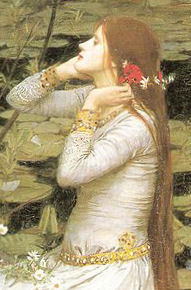
William Shakespeare - 'Valentine' Poetry
Hamlet,
Act IV, Scene 5 (c1600)
Ophelia:
To-morrow is Saint Valentine's day,
All in the morning betime,
And I a maid at your window,
To be your Valentine.

Saint Valentine of Terni and His Disciples - 14th Century
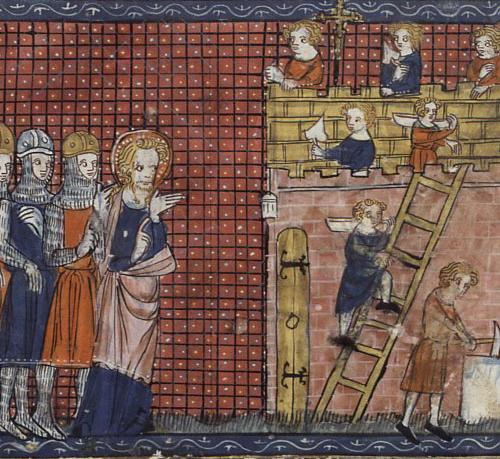
Friedrich V and Princess Elisabeth - Early 17th Century
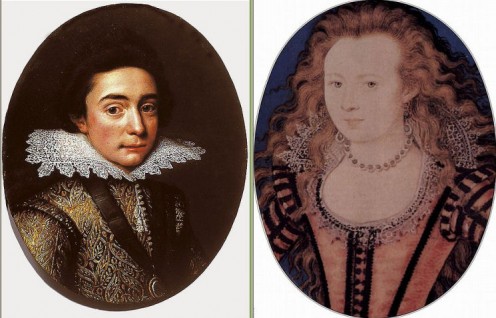
John Donne - Valentine Poetry
Hayle Bishop Valentine whose day this is
All the Ayre is thy Diocese
And all the chirping Queristers
And other birds ar thy parishioners
Thou marryest every yeare
The Lyrick Lark, and the graue whispering Doue,
The Sparrow that neglects his life for loue,
The houshold bird with the redd stomacher
Thou makst the Blackbird speede as soone,
As doth the Goldfinch, or the Halcyon
The Husband Cock lookes out and soone is spedd
And meets his wife, which brings her feather-bed.
This day more cheerfully than ever shine
This day which might inflame thy selfe old Valentine.
* * *
This was written to celebrate the Valentine's Day 1613 marriage of the Elector Palatine to Princess of England.
It was an 'Epithalamion' ~ 'a form of poem that is written specifically for the bride on the way to her marital chamber' [ http://en.wikipedia.org/wiki/Epithalamion ]
Valentine Postcards

Chaucer as Pilgrim - Ellesmere Manuscript - 15th Century
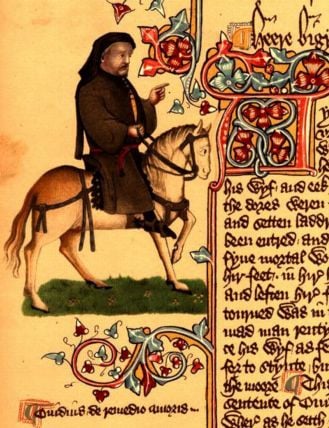
Geoffrey Chaucer
From: 'Parliament of Foules'
“For this was sent on Seynt Valentyne's day
Whan every foul cometh ther to choose his mate.”
By: Geoffrey Chaucer
*
This is from Wikipedia:
'The "Parlement of Foules" (also known as the "Parliament of Fowls", "Parlement of Briddes", "Assembly of Fowls", "Assemble of Foules", or "The Parliament of Birds") is a poem by Geoffrey Chaucer (1343?-1400) made up of approximately 700 lines. The poem is in the form of a dream vision in rhyme royal stanza and is interesting in that it is the first reference to the idea that St. Valentine's Day was a special day for lovers.'
This item gives, as its source for this information, "St. Valentine, Chaucer, and Spring in February", by Jack B Oruch, published in Speculum, 56 (1981).
It continues: 'Oruch's survey of the literature finds no association between Valentine and romance prior to Chaucer. He concludes that Chaucer is likely to be "the original mythmaker in this instance.'
http://en.wikipedia.org/wiki/Parlement_of_Foules
Views of Saint Valentine
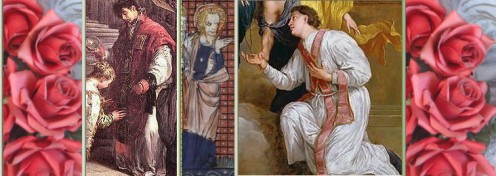
Buster Brown Valentine andv Pop-Up Valentine
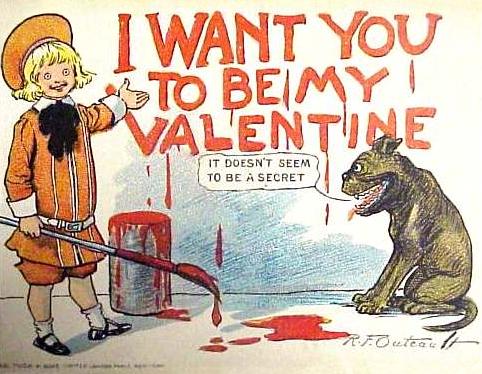
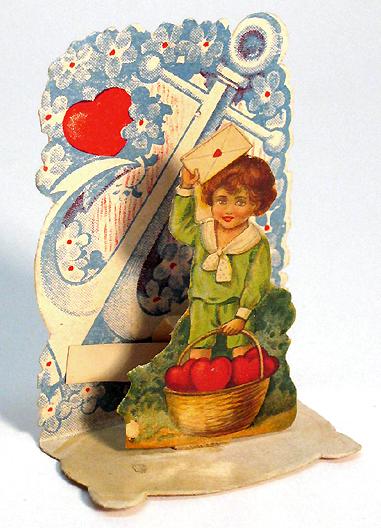
Sources
http://en.wikipedia.org/wiki/Epithalamion
http://www.newadvent.org/cathen/15254a.htm
http://en.wikipedia.org/wiki/Saint_Valentine
http://en.wikipedia.org/wiki/Valentine's_Day
http://www.catholic.org/saints/saint.php?saint_id=159
http://www.thaliatook.com/OGOD/februtis.html
http://en.wikipedia.org/wiki/Juno_Februata
http://www.religioustolerance.org/valentine1.htm
http://en.wikipedia.org/wiki/File:Chaucer_ellesmere.jpg
http://en.wikipedia.org/wiki/Parlement_of_Foules

Bold Loft Love Pillow Cases


My RelatedHubs
- Geoffrey Chaucer and the Canterbury Tales
This hub is something of a miscellany, concerning Chaucer, his life, family, influences, works, the language, etc. It's not exactly a Geoffrey Chaucer biography, from birth to death,... - Saint Patrick and Saint Patrick's Day
Since the 8th century, Patrick has been known as the patron saint of Ireland, but he was not born on 'the Emerald Isle'. He was born in Britain, probably in or around 387 AD. ... - Saint George, Patron Saint of England
Saint George is the patron saint of England ~ celebrated on 23rd April. But who is ~ or was ~ this George? And how did he become the patron saint of us English? ...












